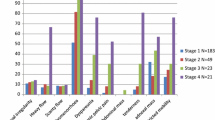Abstract
Purpose
This study was undertaken to evaluate the prevalence of endometriosis in infertile women of couples with non-male factor infertility.
Methods
A retrospective validation analysis was carried out of consecutive women of infertile couples with non-male factor infertility who received combined diagnostic hysteroscopy and laparoscopy, in the period from January 2017 to August 2019 in the Department for Gynecology and Reproductive Medicine (n = 300). Type, stage and site of endometriosis were assessed and matched with the occurrence of tubal stenosis. Binary regression analysis was used to estimate the prevalence of endometriosis.
Results
Endometriosis was diagnosed in 67% (n = 201). Primary infertility (OR 1.76; p = 0.036), dysmenorrhea (OR 2.47; p = 0.002), and a shorter cycle length (OR 0.972; p = 0.036) were independent risk factors for detection of endometriosis in diagnostic hystero-laparoscopy. The most frequent endometriosis sites were pelvic side wall (53.2%) and uterosacral ligaments (41.8%). Patients with endometriosis showed less often a tubal occlusion (34.32% vs. 41.4%; p = 0.205) and presented a lower rate of bilateral obstruction (9.5% vs. 18.8.%, p = 0.024). Women with endometriosis of a Fallopian tube showed a higher rate of tubal occlusion on the same side (right side p = 0.002; left side p = 0.001). Patients with rASRM score III showed the highest rate of tubal obstruction.
Conclusions
The prevalence of endometriosis in infertile women was higher than expected. The indication for operative infertility diagnostics by minimal invasive techniques should be made much more generous as well as the complete clarification of the causes of female infertility.
Similar content being viewed by others
References
Soliman AM, Yang H, Du EX, Kelley WC (2016) The direct and indirect costs associated with endometriosis: a systematic literature review. Hum Reprod 31(4):712–722
Buck Louis GM, Hediger ML, Peterson CM et al (2011) Incidence of endometriosis by study population and diagnostic method: the ENDO Study. Fertil Steril 96(2):360–365
Dunselman GA, Vermeulen N, Becker C et al (2014) ESHRE guideline: management of women with endometriosis. Hum Reprod 29(3):400–412
Uccella S, Marconi N, Casarin J et al (2016) Impact of endometriosis on surgical outcomes and complications of total laparoscopic hysterectomy. Arch Gynecol Obstet 294(4):771–778
Righarts A, Osborne L, Connor J, Gilett W (2018) The prevalence and potential determinants of dysmenorrhoea and other pelvic pain in women: a prospective study. BJOG 125:1532–1539
Missmer SA, Hankinson SE, Spiegelman D, Barbieri RL, Marshall LM, Hunter DJ (2004) Incidence of laparoscopically confirmed endometriosis by demographic, anthropometric, and lifestyle factors. Am J Epidemiol 160:784–796
Collins JA, Burrows EA, Wilan AR (1995) The prognosis of live birth among untreated infertile couples. Fertil Steril 64(1):22–28
D’Hooghe TM, Debrock S, Hill JA, Meuleman C (2003) Endometriosis and subfertility: is the realionship resolved? Semin Reprod Med 2182:243–254
Meuleman C, Vandenabeele B, Fieuws S, Spiessens C, Timmermann D, D’Hooghe TM (2009) High prevalence of endometriosis in infertile women with normal ovulation and normospermic partners. Fertil Steril 92(1):68–74
Akande VA, Hunt LP, Cahill DJ, Jenkins JM (2004) Differences in time to natural conception between women with unexplained infertility and infertile women with minor endometriosis. Hum Reprod 19(1):96–103
Practice Committee of the American Society for Reproductive Medicine (2012) Endometriosis and infertility: a committee opinion. Fertil Steril 98(3):591–598
Tomassetti C, D’Hooghe T (2018) Endometriosis and infertility: insights into the causal link and management strategies. Best Pract Res Clin Obstet Gynaecol 51:25–33
Harb HM, Gallos ID, Chu J, Harb M, Coomarasamy A (2013) The effect of endometriosis on in vitro fertilisation outcome: a systematic review and meta-analysis. BJOG 120(11):1308–1320
Duffy JM, Arambage K, Correa FJ et al (2014) Laparoscopic surgery for endometriosis. Cochrane Database Syst Rev 4:CD11031
Tanbo T, Fedorcsak P (2017) Endometriosis-associated infertility: aspects of pathophysiological mechanisms and treatment options. Acta Obstet Gynecol Sacnd 96:659–667
Prescott J, Farland LV, Tobias DK et al (2016) A prospective cohort study of endometriosis and subsequent risk of infertility. Hum Reprod 31:1475–1482
Romanski PA, Brady PC, Farland LV, Thomas AM, Hornstein MD (2019) The effect of endometriosis in the antimüllerian hormone level in infertile population. J Assist Reprod Genet 36(6):179–1184
Giudice LC (2010) Clinical practice: endometriosis. N Engl J Med 362(25):2389–2398
Ballard KD, Seaman HE, deVries CS, Wright JT (2008) Can symptomatology help in the diagnosis of endometriosis? Findings from a national case-control study-part 1. BJOG 115(11):382–391
Audebert A, Petousis S, Margioula-Siarkou C, Ravanos K, Prapas N, Prapas Y (2018) Anatomic distribution of endometriosis: a reappraisal based on series of 1101 patients. Eur J Obstet Gynecol Reprod Biol 230:36–40
Approbato FC, Approbato MS, Rezende DF, Silva TM, Lima YAR, Benetti BBDC (2019) Endometriosis III and IV as a risk factor for tubal obstruction in infertile women. JBRA Assist Reprod. https://doi.org/10.5935/1518-0557.20190004
Younis JS, Shapso N, Fleming R, Ben-Shlomo I, Izhaki I (2019) Impact of unilateral versus bilateral ovarian endometriotic cystectomy on ovarian reserve: a systematic review and meta-analysis. Hum Reprod Update 25(3):375–391
Acknowledgements
The authors would like to thank Dr Thomas Lehmann, Institute of Medical Statistics, Informatics and Documentation, University Hospital, Friedrich-Schiller-University Jena, Germany, for assistance in project development.
Author information
Authors and Affiliations
Contributions
KN: protocol/project development, data collection and data management and manuscript writing/editing. DB: data collection. RS: data collection. KB: project development. HD: project development. IBR: manuscript writing/editing.
Corresponding author
Ethics declarations
Conflicts of interest
The authors have no conflicts of interest to declare.
Additional information
Publisher's Note
Springer Nature remains neutral with regard to jurisdictional claims in published maps and institutional affiliations.
Rights and permissions
About this article
Cite this article
Nicolaus, K., Bräuer, D., Sczesny, R. et al. A two-third majority of infertile women exhibit endometriosis in pre-ART diagnostic hysteroscopy and laparoscopic chromopertubation: only one-third have a tubal obstruction. Arch Gynecol Obstet 301, 1081–1088 (2020). https://doi.org/10.1007/s00404-020-05479-5
Received:
Accepted:
Published:
Issue Date:
DOI: https://doi.org/10.1007/s00404-020-05479-5




